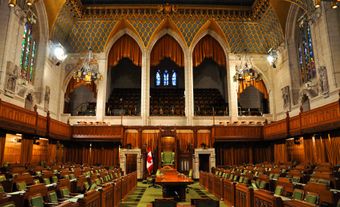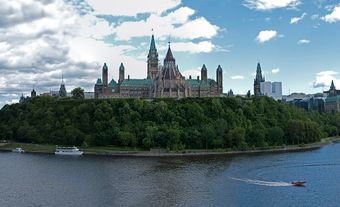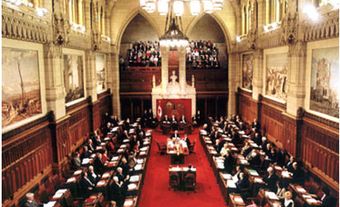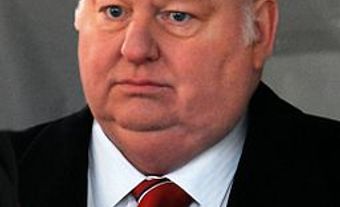The Senate is the Upper House of Canada’s Parliament. Its 105 members are appointed and hold their seats until age 75. The Senate’s purpose is to consider and revise legislation; investigate national issues; and most crucially according to the Constitution, give the regions of Canada an equal voice in Parliament. The Senate is a controversial institution. It has long been regarded by many Canadians as a place of unfair patronage and privilege. An unresolved debate continues about whether it should be reformed into an elected body accountable to the voters, or abolished.

Senators
Senators are appointed by the governor general on the advice of the prime minister. To qualify for appointment, they must be Canadian citizens; at least 30 years old; have real property worth $4,000 free of mortgage and a net worth of at least $4,000 (amounts unchanged since they were enacted during Confederation in 1867); and reside in the province or territory for which they are appointed. In Quebec (which is divided into 24 senatorial divisions), Senators must reside or have their real property in the division for which they are appointed.
Senators lose their seats if they become non-citizens; become bankrupt, insolvent or public defaulters; are convicted of a crime; lose their residence or property qualification; or are absent for two consecutive sessions of Parliament. They receive a salary of $150,600 (as of 2018) plus additional pay if they hold special offices in the Senate (such as government or opposition whip or leader). They also receive other expense and travel allowances.

Red Chamber
The Senate chamber is located on the eastern end of Parliament’s Centre Block. It is adorned in royal red, versus the green of the House of Commons. It is where senators meet and debate, and where the Canadian sovereign or their representative the governor general addresses Parliament and delivers the Speech from the Throne at the beginning of every new session of Parliament. This is also where the ceremony is held to install a new governor general. Proceedings in the Senate chamber, and the proceedings of most senate committees, are open to public viewing.
The chamber is an impressive hall from an architectural and interior design standpoint. It has intricately carved oak panelling and two massive bronze chandeliers. A marble bust of Queen Victoria, Canada’s monarch at the time of Confederation, surveys the chamber from above the speaker’s chair. Eight huge oil paintings on the main walls of the chamber depict scenes of Canadian sacrifices during the First World War.
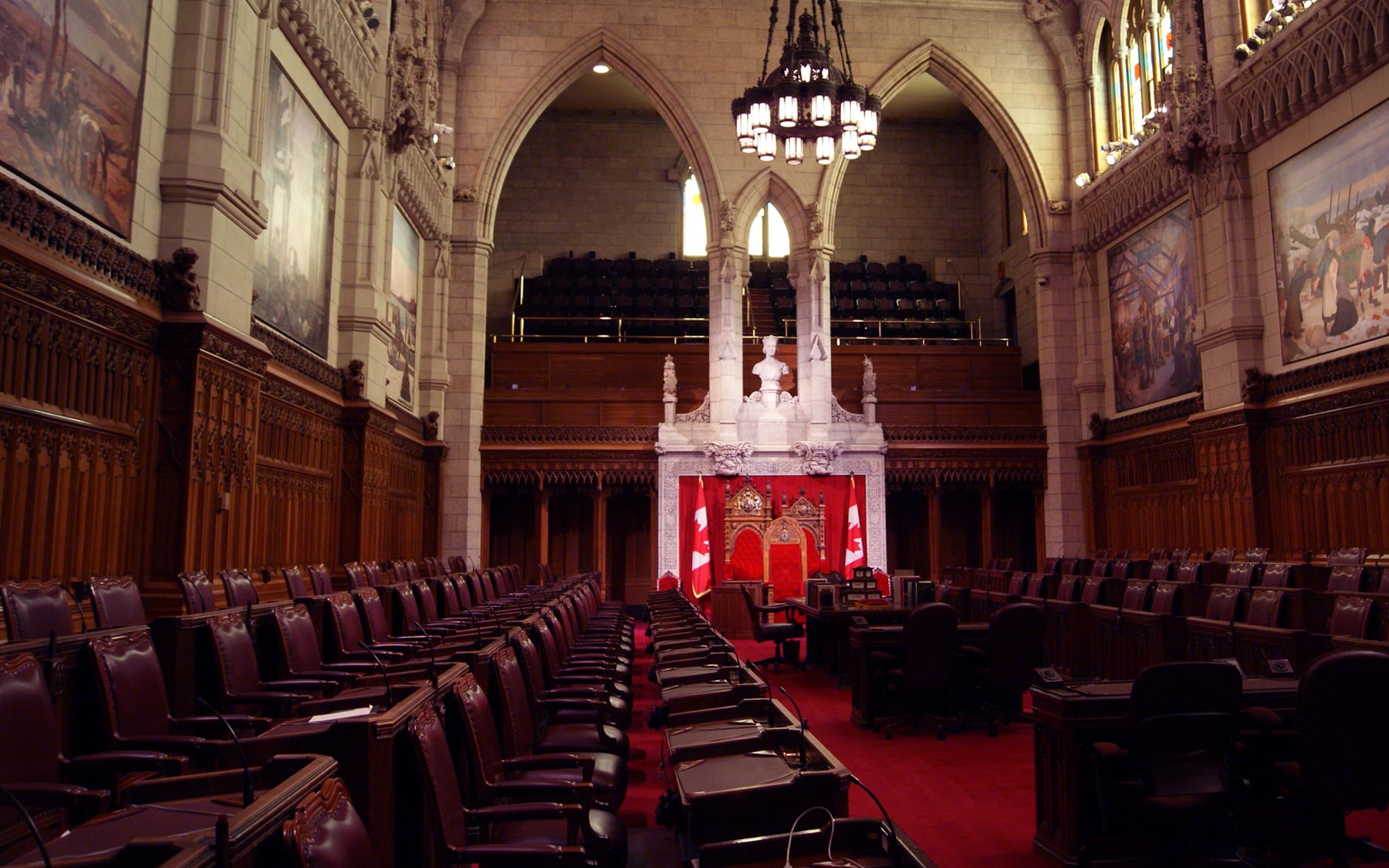
Creation
The Senate was created under the Constitution Act, 1867. Its purpose was primarily to protect regional interests; but also to provide what George-Étienne Cartier called a “power of resistance to oppose the democratic element.”
The House of Commons was to be elected on the basis of representation by population. In 1867, Ontario was the most populous, fastest-growing province; but Quebec and the Maritimes were more important to the national economy than their population suggested. They dared not leave matters such as tariffs, taxation and railways to the mercy of an Ontario-dominated Commons. They insisted on equal regional representation in the Upper House. Without that guarantee, there would have been no Confederation.
Regional Representation
The Senate is therefore designed to balance out the power of the Commons, by giving voice to and protecting the rights of Canada’s regions; particularly regions with small populations that do not have strength-by-numbers in the Commons.
Of the 443 seats in Parliament (as of 2019), 338 or three quarters are in the Commons; 105 or one quarter are in the Senate. Senate seats are divided equally among four divisions:
- Maritimes Division: 24 seats (10 each for New Brunswick and Nova Scotia, four for Prince Edward Island)
- Quebec Division: 24 seats
- Ontario Division: 24 seats
- Western Division: 24 seats (six each for British Columbia, Alberta, Saskatchewan and Manitoba)
There are also nine additional seats representing regions that were not part of the Divisions originally created at Confederation: Newfoundland and Labrador (6), Northwest Territories (1), Yukon (1) and Nunavut (1)
Senators are technically appointed to represent a region; but they have also tended to sit as members of political parties; either government or opposition, depending on whether their party held power in the Commons. As a result, the Senate has operated for much of its history as a partisan political body — its members following instructions from their party leaders in the Commons — rather than as originally intended; as an independent voice for regional interests. This has also fuelled demands that the Senate be reformed or abolished.
Despite its regional focus, the Senate was not set up to represent provincial governments or legislatures; or to protect the provinces against federal invasion of their powers. The courts protect provincial powers. (See also Distribution of Powers.) The protection of provincial interests in matters under federal jurisdiction sometimes falls to the ministers from each province in the federal Cabinet. Canada’s first Cabinet had five senators out of a total of 13 ministers. From 1911 to 1979, there were seldom more than two, and often only one senator in the Cabinet. In 1979, the Conservatives under Joe Clark were so short of Quebec and French-Canadian members of Parliament that they had to include three French-Canadian senators in Cabinet. From 1980 to 1984, the Liberals were equally short of Western MPs and did the same.
Sober Second Thought
The Senate was also intended to provide “sober second thought” on legislation introduced in the Commons. One of its most effective functions is the quiet, in-depth study and review of national issues (including the hearing of expert witnesses) by Senate committees. Committees go over proposed bills clause by clause. They often hear voluminous evidence, sometimes over a period of months.
Committees are usually non-partisan. They can draw on a vast reservoir of members’ knowledge and experience: former federal and provincial ministers; former members of the Commons and provincial assemblies; veteran lawyers and business people; farmers; women and ethnic representatives; and even an occasional trade unionist. Senate committees have produced careful studies on unemployment; land use; science policy; poverty; aging; the mass media; and Indigenous affairs. Senate investigations have often led to important changes in government policy or legislation.
Senate Powers
The Senate has almost the same powers as the House of Commons. Bills are read three times in the Commons as well as in the Senate. The Senate can only delay constitutional amendments for 180 days. But no bill can become law without its consent, and it can veto any bill as often as it likes. The Senate cannot initiate money bills (taxes or expenditures). Neither House can increase amounts in money bills. The Senate has not vetoed a bill from the Commons since 1939. The Senate now very rarely makes amendments of principle. The amendments it does make to bills now are almost always related to drafting; to clarify, simplify and tidy proposed legislation.
In 1987, the Senate temporarily blocked Bill C22 (pharmaceutical patents). But it eventually agreed to amendments. In 1990, the Liberal dominated Senate effectively blocked plans of the Conservative government to pass the legislation for the unpopular Goods and Services Tax (GST). This led Prime Minister Brian Mulroney to use his power to fill eight vacant senate seats; this ensured passage of the legislation in 1990.
The Senate’s legally absolute veto was expected to be really no more than a delaying veto. Until the late 1860s, governments were usually short-lived; none, it seemed, would be able to build up a large enough majority in the Senate to block a successor government of the opposition party. But many Canadian governments since then have served multiple terms. (See Timeline: Elections and Prime Ministers.) Appointments are almost invariably partisan. The Senate has often had a large opposition majority; as well as a heavy preponderance of Liberals through much of the late 20th century. After the election of Stephen Harper’s Conservative government in 2006, however, party power in the Senate shifted. As of 2016, there were 42 Conservative senators, 25 Liberals, 21 independents and 17 vacancies.
Senate Reform
A longstanding objection to the Senate is that, too often, its members are given seats in the Chamber as a reward for service or loyalty to the party in power. Many feel that such patronage appointees have no right to a position of authority in a modern democracy.
Proposals to make the Senate more representative of regional interests were introduced by the Liberal government in 1978; but they received little support. A push for Senate reform was resurrected in the constitutional debates of the late 1980s, and widely debated during the struggles over the Meech Lake and Charlottetown accords.
Some provinces proposed that Senate appointments be turned over to the provincial governments. Senators could act as provincial representatives, defending regional interests. Critics charged that such a system would run counter to the principles of federalism and representative democracy. In the long negotiations over the Charlottetown Accord, the proposal for a so-called “Triple-E Senate” — elected, effective and equal — championed particularly by Alberta premier Don Getty, became a primary focus of debate. Following the collapse of the Meech Lake Accord, Alberta held a provincial election to fill a vacant Senate seat. Although not constitutionally bound to do so, Brian Mulroney appointed the nominee, Stan Waters, to the Senate in 1990. Since then, Alberta and British Columbia have held further non-binding Senate elections; from them, a list of names is given to Ottawa for consideration, whenever Senate seats from those provinces become vacant.
Under the present Constitution, turning the Senate into an elected House would require a constitutional amendment. It would need the consent of seven provincial legislatures, representing at least half the population of the 10 provinces. So, too, would any change in the Senate's powers; or in the number of senators from any province.
Reform Under Harper
The government of Prime Minister Stephen Harper tried twice after 2006 to reform the Senate; each time by submitting legislation through Parliament that sought to avoid a constitutional amendment. Harper’s first Senate reform bill was delayed in the then-Liberal dominated upper house. It never became law. His second attempt — Bill C-7, the Senate Reform Act — was introduced in Parliament in 2011. The bill would have limited Senate terms to nine years and allowed provinces to elect their senators if they chose to do so.
By the end of 2013, the bill had not been debated in Parliament for many months; instead, it came under renewed scrutiny because of a high-profile scandal involving the Prime Minister's Office and three Harper-appointed senators accused of filing improper expense claims (See Canadian Senate Expenses Scandal; Mike Duffy Case.)
As the scandal was underway, the Quebec Court of Appeal, acting on a request by the Quebec government, issued a ruling in October 2013. It found Bill C-7 unconstitutional. The Court said the bill’s proposals require a formal constitutional amendment, not mere parliamentary legislation, if they are to be enacted. The following month the Supreme Court of Canada acted on a request from the federal government; the Court opened its own hearings into Bill C-7 to determine whether the Senate can be reformed without a constitutional change process. This would force Ottawa into negotiations with the provinces.
The federal government also asked the Court for direction on how the Senate could be abolished. The Harper government argued that under the Constitution, abolition only requires the approval of Parliament plus seven provinces representing 50 per cent of Canada's population. Most provinces, however, say abolition requires the formal consent of all 10 provinces.
The Supreme Court issued a unanimous decision on the matter on 25 April 2014. The Court said creating an elected Senate with nine-year term limits required the consent of seven provinces with 50 per cent of the population. And it said abolishing the Senate required the consent of all 10 provinces. In each case, a constitutional amendment would be necessary. “The Senate is a core component of the Canadian federal structure of government,” the Court said. “As such, changes that affect its fundamental nature and role engage the interests of the stakeholders in our constitutional design — i.e., the federal government and the provinces — and cannot be achieved by Parliament acting alone.”
Harper called the ruling “a decision for the status quo.” He said there was little likelihood of Senate reform under his government because the country had no interest in constitutional negotiations that would be required to achieve it.
Reform Under Trudeau
In January 2014, federal Liberal leader Justin Trudeau expelled his party’s then-32 senators from the Liberal Party parliamentary caucus. It had included Liberal members of both the House of Commons and the Senate. Senators who had previously served as Liberals instead became independent members. The change effectively freed Liberal senators from having to vote along party lines. This theoretically reduced the Senate’s role as a partisan body. However, critics said Trudeau made the change not in the spirit of reform; but to distance himself and his party, in the months preceding a federal election, from the expenses scandal that was tarnishing the Senate’s image at the time.
Following this change, the Liberal senators divided themselves into two camps; one group sits as independent senators, while a larger group chooses to call itself the Senate Liberal Caucus (albeit removed from the Liberal caucus in the House of Commons). Many Liberal and independent (former Liberal) senators remained card-carrying members of the Liberal Party of Canada. There was no similar change applied to Conservative senators; they were still members of the Conservative Party parliamentary caucus.
After becoming prime minister, Trudeau in 2016 appointed 22 new independent senators. The first seven of the new group were chosen by a Trudeau-created Independent Advisory Board for Senate Appointments. The remaining 15 were picked by the Advisory Board under a new process that saw more than 2,700 Canadians apply for Senate jobs. This was the first time the government had issued a public call for applications for Senate membership.
One of the first seven appointments, Peter Harder, became the Trudeau government’s “representative” in the Senate. He was responsible for stewarding government legislation through the upper chamber. Previously, the senator in Harder’s post was known as the “government leader in the Senate” and was usually a member of the federal Cabinet. They could command party members in the Senate to support government legislation. Harder would have no such caucus to command; therefore, it remained unclear at the time of his appointment how the Liberal government intended to steer its legislation and its agenda through Parliament’s upper house.
Further Changes
In November 2019, there were several significant changes in the composition of the Senate. Early that month, the Canadian Senators Group was established by former members of the Independent Senators Group, the Conservative Senate Caucus and a non-affiliated senator. On 14 November 2019, the Senate Liberal Caucus disbanded and formed the Progressive Senate Group. This meant that for the first time since Confederation, there were no sitting Liberal senators in the upper house. Only days later, the Progressive Senate Group lost official group status after one of its members joined the Canadian Senators Group.
As of 22 February 2021, the Senate’s 105 seats were divided as follows: 43 members of the Independent Senators Group; 20 Conservatives; 12 members of the Canadian Senators Group; 11 members of the Progressive Senate Group; 5 non-affiliated senators and 14 vacant seats (three from Quebec; two each from Alberta, Saskatchewan and Ontario; and one each from BC, Manitoba, New Brunswick, Nova Scotia, and Newfoundland and Labrador).
See also Senate: Canada’s Best Think Tank.

 Share on Facebook
Share on Facebook Share on X
Share on X Share by Email
Share by Email Share on Google Classroom
Share on Google Classroom

